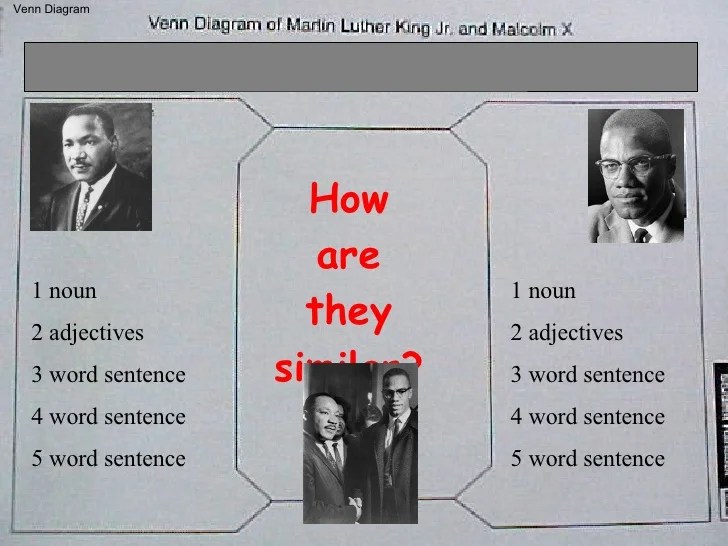Martin luther king and malcolm x venn diagram – In this insightful exploration, we delve into the lives and philosophies of Martin Luther King and Malcolm X, two iconic figures who left an indelible mark on the Civil Rights Movement. Their contrasting ideologies, methods of activism, and impact on American society provide a fascinating lens through which to examine the complexities of racial inequality and the struggle for social justice.
Ideologies and Beliefs

Martin Luther King Jr. and Malcolm X, two iconic figures of the Civil Rights Movement, held contrasting ideologies and beliefs that shaped their activism. King advocated for nonviolent resistance, believing that love and compassion could overcome racial hatred and discrimination.
Malcolm X, on the other hand, espoused armed self-defense, arguing that violence was necessary to protect Black people from white oppression.
King’s philosophy of nonviolence was rooted in his Christian faith and the teachings of Mahatma Gandhi. He believed that peaceful protests, civil disobedience, and boycotts could effectively challenge racial injustice without resorting to violence. Malcolm X, influenced by the teachings of Marcus Garvey, emphasized Black nationalism and self-reliance.
He believed that Black people should establish their own separate communities and institutions, free from white domination.
Racial Integration vs. Black Nationalism
King’s vision for racial integration was based on the belief that all Americans, regardless of race, should have equal rights and opportunities. He sought to create a “beloved community” where people of all races could live together in harmony. Malcolm X, however, rejected the idea of racial integration, arguing that it would only lead to the assimilation of Black people into white society and the loss of their unique identity.
Methods of Activism

King and Malcolm X employed distinct methods of activism to achieve their goals. King organized nonviolent protests, such as the Montgomery Bus Boycott and the March on Washington, to draw attention to racial injustice and demand change. He also used speeches and sermons to inspire and mobilize the masses.
Malcolm X, on the other hand, advocated for armed self-defense and the establishment of paramilitary organizations. He believed that Black people had a right to defend themselves against white violence and that armed resistance was the only way to achieve true freedom.
Effectiveness and Impact, Martin luther king and malcolm x venn diagram
Both King and Malcolm X’s methods of activism had significant impacts on the Civil Rights Movement. King’s nonviolent approach gained widespread support and helped to create a national consensus against racial discrimination. Malcolm X’s more militant stance inspired a new generation of Black activists and raised awareness about the plight of Black people in America.
Impact on the Civil Rights Movement

Martin Luther King Jr. and Malcolm X made immeasurable contributions to the Civil Rights Movement. King’s leadership and advocacy played a crucial role in the passage of landmark legislation, such as the Civil Rights Act of 1964 and the Voting Rights Act of 1965.
Malcolm X’s influence was equally significant. His powerful speeches and unwavering commitment to Black empowerment inspired many young people to join the movement and fight for their rights. He also helped to raise international awareness about the racial injustices faced by Black people in America.
Historical Context

King and Malcolm X lived and worked during a time of intense racial segregation and discrimination in America. The Jim Crow system of laws enforced separation of the races in all aspects of life, from housing to education to employment.
The post-World War II era also witnessed the rise of the Cold War and the struggle for civil rights around the world. King and Malcolm X were both influenced by these global events, and their activism was part of a larger movement for social justice and equality.
Question & Answer Hub: Martin Luther King And Malcolm X Venn Diagram
What were the key differences between Martin Luther King and Malcolm X’s ideologies?
Martin Luther King advocated for nonviolent resistance and racial integration, while Malcolm X embraced armed self-defense and black nationalism.
How did their methods of activism differ?
King relied on protests, speeches, and civil disobedience, while Malcolm X employed more confrontational tactics, including armed self-defense and the establishment of black separatist organizations.
What was their impact on the Civil Rights Movement?
Both King and Malcolm X played pivotal roles in advancing the Civil Rights Movement. King’s nonviolent approach garnered international support and helped to desegregate public facilities and secure voting rights. Malcolm X’s militant stance mobilized black communities and raised awareness of racial injustice.